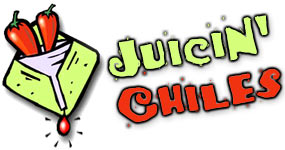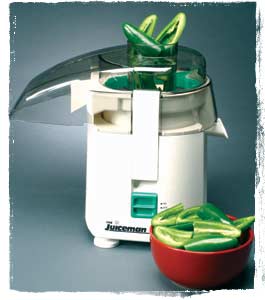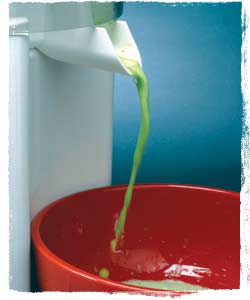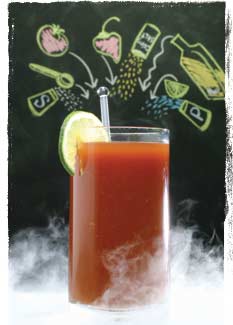By Nancy Gerlach, R.D. & C.S.I
(Registered Dietitian and Culinary Science Investigator)
Recipes:
Bloody Maria
Belizean Habanero Hot Sauce
Pico de Gallo
Fiery Horseradish Cream
Southwest Chile Clam Chowder
Creamy Asparagus Rosemary Soup
Blue Corn Chile Cheese Muffins
Spiced Cranberry Pumpkin Muffins
Spicy Tomatillo Shrimp
|
|
Nancy Gerlach, R.D. and C.S.I. |
After 20 years of writing about chiles, I thought I’d explored all the ways of handling and processing these pungent pods. Then one of our readers had an interesting idea that proved me wrong. He found that he couldn’t puree habaneros fine enough for use in my Belizean hot sauce recipe, so he put them in an automatic juice extractor and then used the juice. In addition to working well in the sauce, he also liked the process. All he did was wash them, put them in the juicer, and then let the machine do the separating and cleaning. This was definitely a new way to process chiles that I needed to explore.
|
|
Filling up the Juicer |
I began my experiments armed with a juicer and bags of chiles, and dressed like a member of a Hazmat Team with gloves and mask. I used serranos, yellow hots, habaneros, poblanos, really huge jalapeñ os, and mild New Mexican green chiles. To prepare them, I removed the stems and, when needed, cut them in pieces that would fit into the feed tube of the juicer. The first pass through the machine yielded a quantity of juice but the pulp had rather large pieces of flesh, so I ran the pulp through a second time before measuring either the juice or the pulp. (See table.)
I juiced the milder chiles (the poblano and New Mexican) first, and then the jalapeñ os. To be honest, I was a little disappointed in the results. They all juiced well enough, but they tasted about the same and didn’t have much heat. That was to be expected with the poblano and the Anaheim, but the jalapeños! Since I couldn’t get much heat out of the jalapeños, I figured that, because of their size, they were the very mild TAM variety. After an unsuccessful search for smaller ones which might have had more heat, I was stuck with a very mild jalapeño juice.
|
|
The Juicing Process |
Since the chiles were producing such mild juice and pulp, and because it was getting hot under my protective gear, I took off the mask before proceeding to the serranos. Big mistake! I didn’t put my face over the machine, yet the fumes still drove me from the room. And after tasting the juice, I had to run to the refrigerator and grab something dairy to quell the fire. After that experience, I didn’t do any more chile juicing without a mask. The remainder of the chiles produced very hot to blistering juice, and the pulp was full of heat, though the juice was definitely hotter.
The fresh chiles juiced so well that I wondered if dried varieties would also work. I re-hydrated a few of the larger, more flavorful varieties (ancho and New Mexican) in hot water for 30 minutes to insure that they were fully softened. They were drained and then juiced. No liquid was produced and the pulp was such a thick paste that it had to be scraped out of the machine. What a mess! Reconstituted dry chiles obviously did not work in a juicer.
|
|
Hot Chile Juice |
First I used the juice as a condiment to spice up simple recipes. Dave told me that he’d tried rocoto juice in plain tomato juice and it was great, so I gave it a try. A squeeze of lemon or lime, some coarsely ground black pepper, a little salt, and chile juice was all that was needed to turn tomato juice into a tasty vegetable juice. How easy! I tried the serrano juice in my version of a Bloody Maria, and it was wonderfully hot without being thick and pulpy. It was also a good way to control the amount of heat in a recipe, as you can add a little at a time, actually drop by drop, until the desired heat level is reached.
|
|
Bloody Maria |
Adding the pulp to salsas was fairly obvious but I did try it anyway. I removed the big pieces from the jalapeño pulp and added the remainder to a simple Pico de Gallo. Since the pulp was more of a mash, it was a little harder to get it mixed into the salsa, but once it was, it was fine. I thought that the salsa was milder than if the whole chile was used, but it still had the flavor.
I wondered next how the pulp would work in baking. One of my favorite muffin recipes, for Blue Corn Chile Cheese Muffins, calls for minced jalapeños but I substituted the remaining 1/4 cup of jalapeño pulp, which was equal to approximately ½ pound of jalapenos. Even though these jalapeñ os were mild, I thought that the pulp would be more evenly distributed and maybe more of the chile taste would be apparent. The muffins were good but they only had a hint of chile taste and no heat. Since the pulp was turning out to be milder than the juice, I tried a tablespoon of habanero juice in some Spiced Cranberry Pumpkin Muffins. The result was muffins with heat that seemed to increase the longer they were stored, but they didn’t have anywhere near the fire that you would expect if you used 6 habaneros in the recipe. What was going on here? Since capsaicin is heat stable, I wouldn’t have thought that cooking with either the pulp or the juice would make much of a difference.
Since the juice wasn’t working all that well in baking, the next step was to experiment with a direct heat method. I usually add green chile to my clam chowder, but since the New Mexican’s juice and pulp were so mild, I substituted the “hot” serrano juice. The soup had some heat but no serrano flavor. It appeared that cooking on top of the stove was also having an effect on the capsaicin. I had more serrano juice so I tried another approach, to confirm that heat was indeed the culprit. I prepared Creamy Asparagus Rosemary Soup but, instead of adding the chile while the soup was cooking, I removed the pot from the heat and stirred in the serrano juice before serving. It worked. The soup was hot and had a nice serrano flavor.
I wondered what effect marinating in the chile juice before cooking has on both heat and flavor, since my baking experiments resulted in mild products and adding the juice to soup as it was cooking didn’t work. I marinated shrimp in a sauce of tomatillos and yellow hot chile juice, and when I tasted the marinade, it had heat. But after the shrimp was grilled, it had no heat and only the flavor of the tomatillos remained.
The conclusion I’ve drawn is this method of handling chiles works in recipes that do not require cooking, such as in drinks and salsas. I also wouldn’t juice the large, milder chiles, as their distinctive flavors and any heat appear to get lost in the process. The pulp worked well in salsas, but I wouldn’t juice the chiles just to produce the pulp. I do think juicing works well with the smaller, fleshy, super hot chiles such as habaneros and rocotos. I grow a fair amount of habaneros in the summer and to save them I’ve been freezing them whole. When defrosted they are too soft for chopping so I either use them whole and remove before serving, or in a recipe that is pureed. I tried freezing the juice as well as the pulp, and both were fine when defrosted; so this year I’m going to juice my habaneros and freeze the juice in ice cube trays, and use it in fresh salsas, uncooked hot sauces, and in drinks.
I encourage you to dust off your juicers and give this a try. Since this is the first time I’ve experimented with the juice of chiles, you may get different results. If you do, let me know.
| Chile Type | Amount | Amount Liquid | Amount Pulp | Heat Scale |
| Anaheim | ½ lb. | 1/3+ cup | 2 tablespoons | Mild |
| Jalapeño | 3/4 lb. | 2/3 cup | 6 tablespoons | Mild |
| Rocoto | 15 | 1/2 cup | 1 cup | Very Hot |
| Serrano | 15 (2 ounces) | 1/4 cup | 5 tablespoons | Hot |
| Poblano | 1 (3 ounces) | 1/4 cup | 3 tablespoons | Mild |
| Yellow Hots | 6 (3 ounces) | 1/4 cup | 5 tablespoons | Hot |
| Habanero | 6 (3 ounces) | 1 tablespoon | 1/4 cup | Fire |
Recipes
This is a “south of the border” Bloody Mary substituting tequila for the vodka. But if you are a purist, use the vodka or leave out the alcohol altogether and have a great morning wake-up drink. Adding the rocotos, rather than Tabasco, added flavor as well as warming the drink nicely. The heat came on slowly and lingered. This is one of the best uses for chile juice.
-
8 ounces tomato juice
-
2 ounces tequila
-
1 teaspoon rocoto juice
-
½ teaspoon lime juice
-
Dash Worcestershire sauce
-
Dash celery salt
-
Freshly ground black pepper
-
Salt to taste
-
Garnish: Lime wedge
Combine all the ingredients in a pitcher and mix well. Fill a tall glass with ice, pour the juice over the ice, garnish with a lime wedge and serve.
Yield: 1 serving
Heat Scale: Hot
In this recipe I never cooked the habaneros in order to preserve their distinctive flavor, so it was a perfect choice for our readers’ first experiment with juicing chiles. After cooking and pureeing the sauce, stir in the habanero juice. The final consistency of the sauce was very smooth, very hot, and had a strong habanero flavor.
-
1 small onion, chopped
-
2 cloves garlic, chopped
-
1 tablespoon vegetable oil
-
1 cup chopped carrots
-
1/4 cup lime juice, fresh preferred
-
2 tablespoons distilled vinegar
-
1 teaspoon salt
-
1/3 to ½ cup habanero juice
In a saucepan, saute the onion and garlic in the oil until soft. Add the carrots and 2 cups of water and bring to a boil. Reduce the heat and simmer until the carrots are soft.
Remove from the heat and transfer the mix to a blender or food processor. Add the lime juice, vinegar and salt, and puree until smooth. Add the habanero juice and mix well.
Store the hot sauce in a glass bottle.
Yield: 1½ cups
Heat Scale: Extremely Hot
This salsa is so simple it really doesn’t need a recipe at all. But since I did use it in my experiments, I’ve included it here. It is also good made with serranos.
-
1 tomato, finely chopped
-
1/4 cup finely chopped onion
-
1 clove garlic, minced
-
2 tablespoons finely chopped cilantro
-
2 tablespoons jalapeñ o pulp
-
Lime juice to taste
-
Salt to taste
Combine all the ingredients together in a non-reactive bowl. Allow the salsa to sit at room temperature for at least an hour before serving to combine the flavors.
Serve with chips as a dip, or as a topping for such items as tacos, burritos, and fajitas.
Yield: 1 to 1½ cups
Heat Scale: Mild to Medium
This creamy sauce delivers a double punch, from the horseradish and the chile. Serve it as an accompaniment to grilled salmon, poached fish, prime rib, or even corned beef. Horseradish is very volatile and loses its flavor and aroma quickly, so this sauce should be made just before serving.
-
1 cup sour cream
-
1 teaspoon white vinegar
-
1 teaspoon sugar
-
2 to 3 tablespoons freshly grated horseradish
-
2 teaspoons habanero pulp
Combine the sour cream, vinegar, and sugar in a bowl and beat until stiff. The cream will become very thin just before it starts to peak.
Stir in horseradish and habanero pulp and serve.
Yield: 1 cup
Heat Scale: Hot
I usually add chopped green New Mexican chile to this recipe but since the only fresh green chile I could find were Anaheims that were too mild, I decided to use the juice from the serranos since I knew it was hot.
-
1 large potato, peeled and diced
-
1/4 pound bacon, cut in ½-inch pieces
-
1 cup diced onion
-
½ cup diced celery
-
1/4 cup all-purpose flour
-
1 bottle clam juice
-
1 10-ounce can clams, drained, liquid reserved
-
1 6-ounce can minced clams, drained, liquid reserved
-
1 cup whole kernel corn
-
1 tablespoon serrano juice
-
1 teaspoon fresh thyme
-
1 cup half and half
-
1/4 cup dry sherry (optional)
-
Salt and freshly ground black pepper
Pre-cook potatoes either in a saucepan or in the microwave almost soft. Drain.
In a large stock pot or saucepan, cook the bacon over medium heat for 4 to 5 minutes or until the fat is rendered, being careful the bacon doesn’t brown. Add the onion and celery and continue to saute until the vegetables are soft. If needed, add vegetable oil.
Stir the flour into the vegetable mixture and continue to cook for 3 to 4 minutes, stirring constantly so that the roux doesn’t brown.
Slowly stir in the clam juice, both bottled and reserved. Stir constantly to eliminate any lumps. Add 3 to 4 cups water, the potatoes, corn, serrano juice and thyme, and season with salt and pepper. Simmer the soup for 15 minutes.
Remove the soup from the heat, add the clams, and stir in the half and half and sherry. Ladle the soup into individual bowls, garnish with freshly ground black pepper and serve.
Yield: 4 as an entree, 6 to 8 as an accompaniment
Heat Scale: Mild
Creamy Asparagus Rosemary Soup
I always make this soup in the spring when the fresh asparagus is plentiful. It does freeze well but the asparagus doesn’t, so I omit any garnish pieces of the vegetable when putting this soup up. Although a creamy soup, the texture is achieved by adding potato rather than cream (although I will sometimes add a dash before serving). I would normally add heat by throwing in some chiltepins when cooking, but the serrano juice worked well when added just before serving.
-
1 pound fresh asparagus, cut in pieces, reserving the tips
-
1 large potato, peeled and chopped in small pieces
-
1/4 cup chopped onions
-
4 shallots, chopped
-
2 cloves garlic, chopped
-
1 tablespoon chopped fresh rosemary
-
1/4 teaspoon fresh thyme
-
1/4 teaspoon ground white pepper
-
1 quart chicken broth
-
Salt to taste
-
1/4 cup cream or half and half, optional
-
2 tablespoons serrano juice
-
Garnish: Rosemary leaves
Combine the asparagus, potato, onions, shallots, garlic, rosemary, thyme, pepper, and broth in a stock pot or large saucepan. Bring the soup to a boil, reduce the heat and simmer for 20 to 30 minutes or until the vegetables are very soft.
Remove the pot from the heat and put the contents in a blender or food processor and puree until smooth. Strain the mixture, through a sieve, back into the pot. Season with salt and add the asparagus tips.
Simmer the soup for 5 to 6 minutes or until the tips are just done.
Remove the soup from the heat and stir in the cream and serrano juice.
Ladle the soup into a tureen or individual soup bowls, garnish with a few rosemary leaves and serve.
Yield: 4 servings
Heat Scale: Medium
Blue Corn Chile Cheese Muffins
I like to use blue corn in this recipe because of its nutty taste. But if you don’t have blue corn available, substitute yellow cornmeal. They will still be just as good. Another tasty variation is to add crumbled bacon to the mix. Normally I use 4 chopped jalapenos but I substituted the jalapeno pulp for this experiment. Serve these in place of cornbread with barbecues, picnics, or even as a breakfast muffin.
-
1 cup all-purpose flour
-
3/4 cup blue cornmeal
-
1/3 cup sugar
-
3 teaspoons baking powder
-
3/4 teaspoons salt
-
1 cup milk
-
1 egg, beaten
-
½ cup grated cheddar cheese
-
3 tablespoon melted margarine
-
1/4 cup jalapeñ o pulp
Preheat an oven to 425 degrees F.
Sift all the dry ingredients together in a large mixing bowl.
In another bowl, combine all the remaining ingredients. Add the liquid to the dry ingredients and stir to just mix them.
Lightly oil a muffin pan and divide the batter evenly among 12 to 15 muffin cups, filling up each one about halfway. Bake for 15 to 20 minutes or until a toothpick inserted into the middle of a muffin comes out clean.
Cool the muffins on a rack and serve them warm or at room temperature.
Yield: 12 to 15 muffins
Heat Scale: Mild
Spiced Cranberry Pumpkin Muffins
These muffins have all the ingredients you would find in a traditional Thanksgiving meal with the exception of one the Pilgrims never heard of–chile! With the availability of frozen cranberries and canned pumpkin, you can enjoy these tasty muffins anytime of the year–you don’t need to wait until the fall.
-
1 1/4 cups all-purpose flour
-
3 teaspoons baking powder
-
1/4 teaspoon salt
-
½ teaspoon ground cinnamon
-
1/4 teaspoon ground nutmeg
-
½ cup vegetable shortening
-
3/4 cup sugar
-
2 eggs
-
1 cup canned pumpkin
-
½ cup milk
-
1 tablespoon habanero juice
-
2 teaspoons orange zest
-
½ cup cranberries, fresh or frozen, cut in half
Preheat an oven to 375 degrees F.
Sift all the dry ingredients together in a bowl.
In another large mixing bowl, cream the shortening and sugar together until fluffy. Add the eggs, one at a time, beating well after each addition. Beat in the pumpkin and mix well.
Add 1/3 of the dry ingredients to the mixture and combine well. Add half of the milk and mix. Then add another third of the dry ingredients, and then the remainder of the milk, habanero, and the zest, and finish with the remainder of the dry ingredients.
Lightly oil a muffin pan and fill two-thirds full with the batter. Bake for 20 minutes or until a toothpick inserted into the middle of a muffin comes out clean.
Cool the muffins on a rack before removing and serve them warm or at room temperature.
Yield: 12 large muffins
Heat Scale: Medium to Hot
This is a quick and easy recipe that can be used as a marinade, dipping sauce, or as topping to grilled fish or poultry. I even use it as a flavoring in rice. If you are using the sauce for dipping after it’s been used as a marinade, for safety’s sake it must be simmered for 15 to 20 minutes before serving.
-
1/4 cup diced onion
-
1 clove garlic, minced
-
1 tablespoon vegetable oil
-
2 large tomatillos
-
1/4 cup lime juice, fresh preferred
-
2 tablespoons chopped fresh cilantro
-
2 tablespoons yellow hot chile juice
-
Freshly ground black pepper
-
1 pound shelled shrimp
Heat the oil in a skillet and saute the onion and garlic in the oil until soft.
Put the tomatillos, onion mixture, lime juice, cilantro, and chile juice in a blender or food processor and puree until smooth. Season with the pepper.
Marinate the shrimp in the mixture for an hour. Remove the shrimp and thread them on skewers for grilling.
Put the remaining marinade in a saucepan and simmer for 15 to 20 minutes. Heat the grill until medium-hot.
Grill the shrimp for about 6 minutes or until they are pink and opaque. Remove and serve the shrimp with the sauce on the side for dipping.
Yield: 4 servings
Heat Scale: Mild










